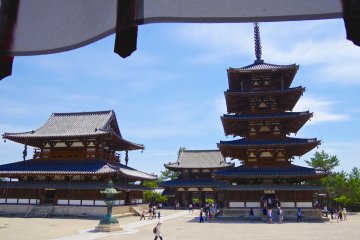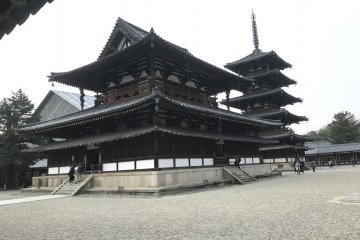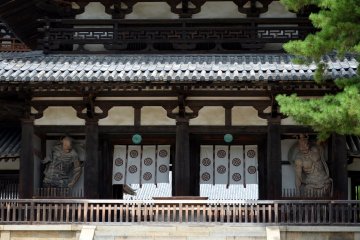
호류지의 사이인가란
Tomoko Kamishima스이코천황의 섭정을 맡았던 쇼토쿠태자(574-622)는 나라의 질서와 평화를 유지하기 위해 불교를 전파하고 그 실천자인 승려를 교육하는 것을 목적으로 호류지의 사이인가란을 건립했다. 호류지 건립은 불교국으로서의 일본의 여명을 알리는 일대 프로젝트였던 것이다.

Japan is filled with a wide variety of temples, ranging from modest to opulent and from massive to small. Horyuji in Nara stands out from the rest as it is, not only, one of Japan’s oldest temples, but also home to the world’s oldest surviving wooden structures, making it a one-of-a-kind destination.
Horyuji’s conception began with Emperor Yomei who desired to build a temple and image of Buddha as a form of prayer to combat an illness he was suffering from. Tragically, Emperor Yomei passed away before he could accomplish this goal. Despite this misfortune, the emperor’s wishes lived on with his son. Prince Shotoku honored his father and established the temple in 607. Soon after, in 670, a fire destroyed multiple temple buildings, which were quickly rebuilt by the early 8th century. However, some historians debate whether this fire actually occurred.
Given Prince Shotoku’s profound influence in the early introduction of Buddhism to Japan, Horyuji has stood as a faithful beacon of the religion for centuries and is a preserved storyteller of that history with over 2,300 important cultural and historical structures and articles onsite.
Horyuji is recognized as a UNESCO World Heritage Site and is the first site to receive this designation in Japan. The temple is divided into two precincts—Western (Saiin Garan) and Eastern (Toin Garan). The Western Precinct is centered around Horyuji’s Five-Story Pagoda and Main Hall (Kondo), while the Eastern Precinct is centered around the Hall of Visions (Yumedono). Walk through the expansive 14.6-hectare temple grounds, admire some of the earliest Buddhist structures in Japan, and immerse yourself in the historic atmosphere. Listed below are the must-see spots at Horyuji. Aside from these highlights, the temple is filled with noteworthy buildings, such as a Bell Tower, a library, halls, gates, and more. Be sure to dedicate multiple hours to the magnificent temple.
Take the Yamatoji Line from JR Nara Station to Horyuji Station (12-13 minutes). From Horyuji Station, the temple is about a 20-minute walk or a 5-minute bus ride via local bus number 72. Alternatively, you can take bus number 97 from JR Nara or Kintetsu Nara Station to Horyuji-mae bus stop (about one hour), which is a few minutes walk from the temple.

스이코천황의 섭정을 맡았던 쇼토쿠태자(574-622)는 나라의 질서와 평화를 유지하기 위해 불교를 전파하고 그 실천자인 승려를 교육하는 것을 목적으로 호류지의 사이인가란을 건립했다. 호류지 건립은 불교국으로서의 일본의 여명을 알리는 일대 프로젝트였던 것이다.



Yakushiji Temple is regarded as one of the oldest and most important temples in Japan, which is no surprise given its impressive status. The temple is recognized as a UNESCO World Heritage Site, the headquarters of the Hosso Sect of Buddhism, and one of the Seven Great Temples of Nara. Emperor Tenmu founded the temple in 680 and dedicated it to Yakushi Nyorai (the Buddha of Healing) to aid his wife—who later became Empress Jito—in her recovery from an illness. Yakushiji was originally located in Fujiwara-kyo, but later moved to Nara in 718, where it still stands today. Although all of the original temple structures, except the East Pagoda, were lost to fires, the temple’s present-day reconstructions accurately reflect its traditional and grand design. Today, visitors and students of Buddhism flock to the site for spiritual learning, healing, and prayer. In addition to the main temple buildings listed below, Yakushiji is home to Yasumigaoka Hachimangu Shrine, other traditional halls, and Buddhist artwork and artifacts. Do not pass up the opportunity to visit Yakushiji’s distinguished temple grounds and immerse yourself in the sacred and educational atmosphere.

Toshodaiji Temple, located just north of Yakushiji Temple in Nara, is a significant site related to the development of Buddhism in Japan and signifies a connection between Japanese and Chinese cultures. The prestigious temple was founded in 759 by the Chinese monk Ganjin, who traveled to Japan in 754 after being asked by the emperor to help train monks and improve Japanese Buddhism. After retiring, Ganjin was granted land and consequently, established Toshodaiji to continue teaching Chinese Buddhist principles. Today, the temple is recognized as a UNESCO World Heritage Site. Without a doubt, Toshodaiji’s most impressive structure is its Kondo, or Main Hall, which was reopened to visitors in 2009 after nearly ten years of reconstruction work. The one-story Kondo, situated directly behind the Nandai-mon (Southern Great Gate), is the epitome of early Japanese-Buddhist architecture with a tiled sloping roof, seven bays, columns, and dark wood tones. Due to the building’s columned facade, it is often compared to the Parthenon. Inside, the hall houses principal Buddhist statues, which are designated as National Treasures. Standing before the hall, you cannot help but be swept away by its commanding presence. Near the Kondo is the Kodo Lecture Hall. This structure was originally built as an administrative building for the Nara Imperial Palace, but later relocated to Toshodaiji after it was gifted to Ganjin. Today, the hall is the only surviving building of the palace, and thus, a historically significant and rare part of the temple. Another prominent temple building is the Miei-do, which enshrines a famous wooden sculpture of Ganjin that his disciples created using hollow-core, dry-lacquer techniques. The exclusive building is only open to the public for a few days a year around June 6th. For all other days, visitors can view a replica of the statue, which was made on the 1,250th anniversary of Ganjin’s death, on display at the nearby Kaizando. In the eastern woods of the precinct lies Ganjin’s grave, one of the most tranquil areas of the temple. Follow a nature-laden path through thick foliage and then cross over a small bridge into the peaceful haven. Toshodaiji is also home to monk sleeping quarters, storehouses for sutras and treasures, and the Koro (Shariden), which is the site of the Uchiwamaki Ceremony, or Fan Scattering Festival, on May 19. Be sure to visit this remarkable temple and walk the footsteps of one of the most influential Chinese monks of Japanese Buddhism.

서부 나라 지역은 오사카에서 불과 30분 거리에 위치한 나라 현의 북서부에 위치한 풍부한 역사적, 문화적 의미가 있는 문화의 요충지입니다. 야마토코리야마시, 헤구리시, 산고시, 이카루가시, 안도시, 그리고 오지시를 포함하여 6개의 도시와 마을로 이뤄진 지역입니다. 이 지역은 나라가 수 세기 전으로 거슬러 올라가 일본의 수도 (710-794)였던 시절 그대로의 전통을 보여줍니다. [photo id='237540'] 서부 나라의 추천 명소를 둘러보기 전에 이곳에서만 볼 수 있는 문화를 어떻게 방문객들에게 다가오게 하는지 알아보세요. 호류지사 [photo id='237554'] 이카루가 마을에 있는 호류지사는 일본에서 가장 유명한 사원들 중 하나입니다. 607년에 설립된 이곳은 일본에서 가장 오래된 사원들 중 하나이며, 현존하는 세계에서 가장 오래된 목조 건축물을 포함하고 있습니다. 1993년 일본에서 처음으로 유네스코 세계 문화 유산으로 지정된 장소입니다 (다른 한 곳은 히메지 성입니다). 서쪽 경내와 동쪽 경내를 가로질러 사찰 경내를 산책하는 것이 추천되며, 5층 탑, 보물 전시과 그리고 주구지사를 포함한 다양한 문화적 장소들을 지나게 될 것입니다. 주구지는 국보로 등록된 미소로 유명한 앉아있는 불상이 있는 곳입니다. 기타 서부 나라 명소 시기산 초고손시지사 [photo id='237553'] 산 정상의 초고손시지사는 6세기로 거슬러 올라가 시기 산의 남쪽 비탈에 자리잡고 있는 고대 불교 성지입니다. ‘호랑이 사원’으로도 불리우는데, 호랑이띠의 해였던 연도에 쇼토쿠 왕자가 모노노베 가문과의 전쟁에서 승리를 위해 이곳을 방문하여 기도를 올렸다합니다 (그는 호랑이의 해에, 호랑이의 날에, 그리고 호랑이의 시간에 기도했다고 합니다). 오늘날은 입구에서 세계에서 가장 큰 혼응지제 호랑이로 간주되는 후쿠토라상을 목격하고 지나가는 사람들에게 행운을 준다고 믿어지는 어두운 산토라 노 후쿠 타이나이 메구리(일명 ‘호랑이 터널’)을 통해 걸으실 수 있습니다.. 여기에서 관광객들은 또한 (매년 가을 전시되는) 시기산 엔기 에마키 두루마리를 볼 수 있습니다. 만화 같은 역사적인 이야기를 지닌 이곳은 현재 만화에도 영향을 주었습니다. 고리야마 성 유적 [photo id='237552'] 16세기 성의 잔해를 찾기 위해 야마토코리야마시에 위치한 고리야마 성 유적을 방문해 보세 요. 도요토미 히데나가경에 의해 지어진 고리야마 성은 이 지역의 역사에 전략적인 역할을 했지만 에도 막부의 해체 후 파괴되었습니다. 내부 해자와 돌담을 포함한 유적은 일본의 봉건 시대를 엿볼 수 있으며, 주변에서 즐길 수 있는 경치가 있습니다. 3월 말에서 4월 초 사이의 벚꽃 시즌 동안 여러분은 또한 성의 야경을 즐길 수 있습니다. 일본의 옛 수도로서, 지역에 산재해 있는 유명한 신사와 절들이 이곳이 나라의 문화적 진원지로서의 역할을 함을 나타냅니다. 이러한 예 외에도, 호키지(유네스코 세계문화유산), 호린지, 아쿠나미 신사, 다루마지, 마츠오 데레사, 고급스러운 문화적 융단 등이 이 지역을 정의합니다. 오늘날의 서부 나라 서부 나라는 관광객들이 현재의 나라를 즐길 수 있는 방법을 고안 중입니다. 새 고슈인 책 [photo id='237538'] 이 지역의 전통 문화와 역사에 대한 이해와 관점을 넓히는데에 도움을 주기 위해, 서부 나라 지역만을 위한 새로운 고슈인초 책이(고슈인, 즉, 빨간 도장을 위한 책) 제작되고 있습니다. 전통적으로 신사 및 사찰 방문을 기록하고 자신의 헌신을 보여주기 위한 가시적인 방법인 고슈인 책은 독특한 미학을 담고 있는 독특한 기념물을 찾는 방문객들에게 추천됩니다. 게다가, 서부 나라를 위한 이 새로운 고슈인 책은 신사 및 사찰을 방문 할 때 올바른 에티켓과 다국어 정보가 포함된 삽입물을 포함합니다. 또한 참여하는 신사 및 사찰을 위한 공식 웹사이트로 이어지는 편리한 QR코드와 디지털 지도를 포함하고 있습니다. 프리미엄 빙수 [photo id='237539'] 디지털 지도를 통해 일본의 대표적인 여름 간식 중 하나인 카키고리(빙수)를 제공하는 곳들의 위치를 볼 수 있습니다. 문화 유산뿐만 아니라, 서부 나라는 얼음을 먹는 문화의 발상지로 여겨지기도 합니다. 두 히무로 신사(나라시와 텐리시)는 인공 얼음과 얼음 냉장고의 수호자로 여겨지는 히무로(직역: “얼음 방”)를 숭배한다고 전해집니다. 이것은 카키고리가 이 지역과 단단한 연결고리를 통해 특별함을 유지하고 있고, 점점 더 많은 수의 가게들이 늘어나 달콤한 간식을 제공하고 있습니다. 일본에서 가장 풍부한 경험으로 알려진 항공사 중 하나인 JAL과의 협업 덕분에 서부 나라의 카키고리도 발전하고 있습니다. 방문객들은 지역 매장에서 프리미엄 빙수 옵션을 독점으로 선보임으로써 서부 나라를 맛볼 수 있습니다. 지역 농산물과 지역 특산품을 사용하여 JAL의 국제선 일등석 페이스트리 셰프는 나라에서 영감을 받은 신메뉴를 개발 중입니다. 이 지역의 농업 기술과 현지에서 재배한 과일(무화과, 코토카 딸기, 배, 포도, 감)의 품질을 고려할 때, 새로운 프리미엄 메뉴는 여름에 완벽한 현지 풍미를 재현할 예정입니다. 이뿐만 아니라, 관광객들이 지역을 방문할 때 즐길 수 있는 보다 지속가능한 관광과 더 의미 있는 경험을 위한 ‘슬로우 푸드’의 재미를 더합니다. 이 흥미로운 프리미엄 달콤한 간식은 서부 나라 지역의 다양한 가게에서 약 2,000엔부터 구입 가능합니다. 가게 위치는 앞서 언급한 고슈인 신간에 나와 있을 뿐만 아니라 지역의 신사 및 사찰에 게시된 디지털 지도를 통해 확인 가능합니다.